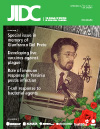Knowledge, attitudes and practices regarding head lice infestations in rural Nigeria
DOI:
https://doi.org/10.3855/jidc.1746Keywords:
KAP study, pediculosis, NigeriaAbstract
Introduction: Head lice infestations are common in sub-Saharan Africa, but knowledge, attitudes and practices have never been studied in this region.
Methodology: This population-based study was conducted in a small rural community (population = 590) in Kwara State, Central Nigeria. Inhabitants of the community were interviewed regarding head lice infestations, using a pre-tested structured questionnaire, and examined regarding the presence of active pediculosis.
Results: Of the 496 participants included, 367 (74.0%) had experienced head lice infestations, but only 26 (11.1%) of the individuals older than 15 years knew the correct mode of transmission. Of 142 individuals with active pediculosis, only 1 (0.7%) felt ashamed. Treatment was most commonly done by grooming (46.3%), followed by combing (27.2%). Only 4.6% used pediculicides, and 21.8% did not apply any treatment. Opinions about difficulties in controlling head lice were asked in three groups: biological, technical and social. In the first group, the most common difficulty noted was detecting head lice (52.1%), followed by possible resistance that would lengthen the time of infestation (38.9%). Technical constraints included concerns on the safety and effectiveness of products (48.7%) and difficulties in obtaining treatment (46.2%). Social contraints included difficulty in treating children (24.4%), lack of knowledge (23.5%), and the social behavior of children (22.2%).
Conclusions: Head lice were not perceived as an important disease in a rural Nigerian community, and feelings about the infestation were mostly indifferent. Despite its common occurrence, knowledge on head lice was limited.
Downloads
Published
How to Cite
Issue
Section
License
Authors who publish with this journal agree to the following terms:
- Authors retain copyright and grant the journal right of first publication with the work simultaneously licensed under a Creative Commons Attribution License that allows others to share the work with an acknowledgement of the work's authorship and initial publication in this journal.
- Authors are able to enter into separate, additional contractual arrangements for the non-exclusive distribution of the journal's published version of the work (e.g., post it to an institutional repository or publish it in a book), with an acknowledgement of its initial publication in this journal.
- Authors are permitted and encouraged to post their work online (e.g., in institutional repositories or on their website) prior to and during the submission process, as it can lead to productive exchanges, as well as earlier and greater citation of published work (See The Effect of Open Access).








